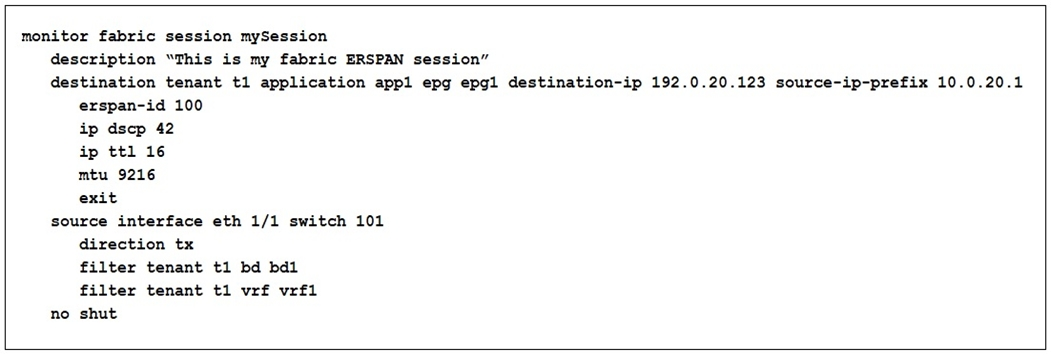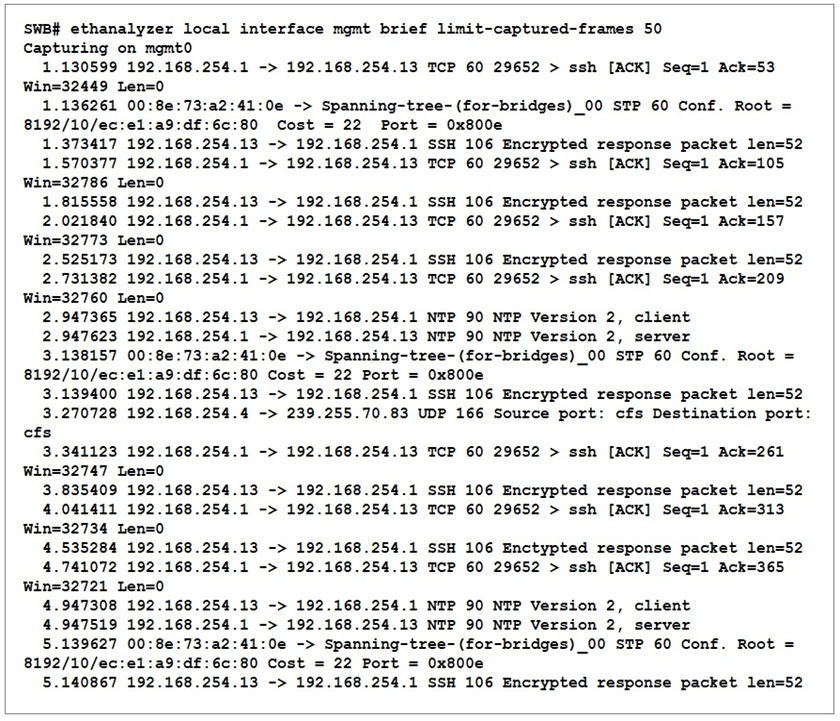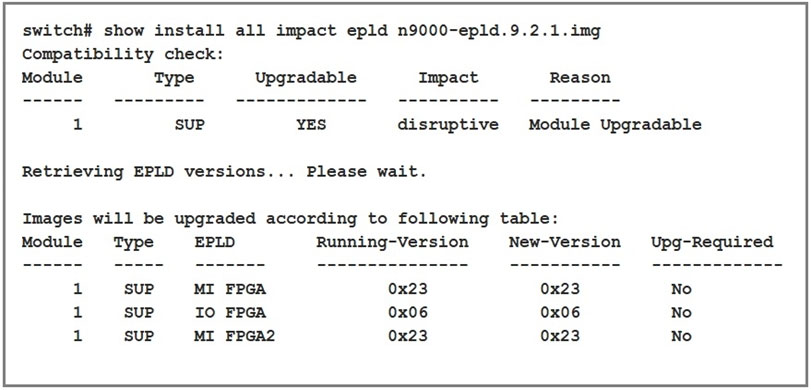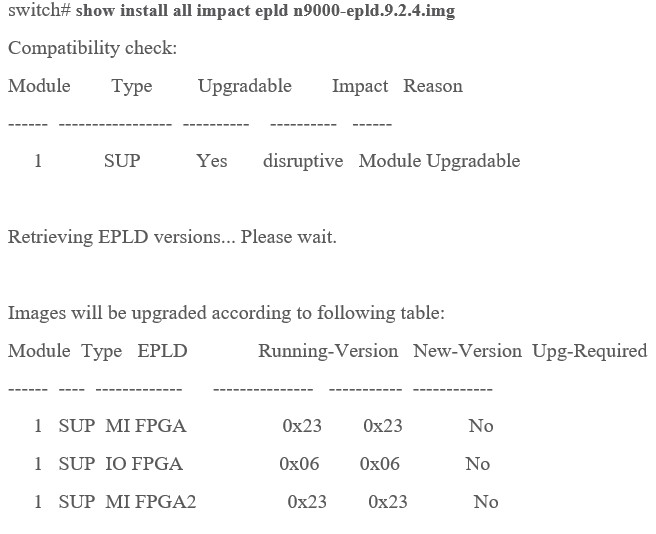Cisco® 350-601 Exam Practice Questions (P. 4)
- Full Access (526 questions)
- One Year of Premium Access
- Access to one million comments
- Seamless ChatGPT Integration
- Ability to download PDF files
- Anki Flashcard files for revision
- No Captcha & No AdSense
- Advanced Exam Configuration
Question #31
What occurs when running the command install deactivate <filename> while a software maintenance upgrade is performed on a Cisco Nexus 9000 Series switch?
- AThe current set of packages is committed.
- BThe package features for the line card are disabled.Most Voted
- CThe package is removed from the switch.
- DThe current upgrade stops.
Correct Answer:
B
Reference:
https://www.cisco.com/c/en/us/td/docs/switches/datacenter/nexus9000/sw/6-x/system_management/configuration/guide/ b_Cisco_Nexus_9000_Series_NX-OS_System_Management_Configuration_Guide/sm_smu.html#task_B8B0F5BA80BE41AEA93197F560665648
B
Reference:
https://www.cisco.com/c/en/us/td/docs/switches/datacenter/nexus9000/sw/6-x/system_management/configuration/guide/ b_Cisco_Nexus_9000_Series_NX-OS_System_Management_Configuration_Guide/sm_smu.html#task_B8B0F5BA80BE41AEA93197F560665648
send
light_mode
delete
Question #32
An engineer installed a new Nexus switch with the mgm0 interface in vrf management. Connectivity to the rest of the network needs to be tested from the guest shell of the NX-OS. Which command tests connectivity from the guest shell of the NX-OS?
- A[guestshell@guestshell ~]$ dohost ''ping vrf management 173.37.145.84''
- B[guestshell@guestshell ~]$ chvrf management ping 173.37.145.84Most Voted
- C[guestshell@guestshell ~$ ping 173.37.145.84 vrf management
- D[guestshell@guestshell ~]$ iping vrf management ip 173.37.145.84
Correct Answer:
B
Reference:
https://www.cisco.com/c/en/us/td/docs/switches/datacenter/nexus9000/sw/7-x/programmability/guide/b_Cisco_Nexus_9000_Series_NX-
OS_Programmability_Guide_7x/Guest_Shell.html
B
Reference:
https://www.cisco.com/c/en/us/td/docs/switches/datacenter/nexus9000/sw/7-x/programmability/guide/b_Cisco_Nexus_9000_Series_NX-
OS_Programmability_Guide_7x/Guest_Shell.html
send
light_mode
delete
Question #33
A DNS server with IP address 192.168.1.1 is deployed in a data center. A network engineer must configure a Cisco UCS Fabric Interconnect to use this DNS.
Which configuration should be applied?
Which configuration should be applied?
- Aficl-mgmt-A# scope fabric-interconnect a ficl-mgmt-A /fabric-interconnect # set name 192.168.1.1 ficl-mgmt-A /fabric-interconnect # scope system ficl-mgmt-A /system # commit-buffer
- Bficl-mgmt-A# scope system ficl-mgmt-A /system # create dns 192.168.1.1 ficl-mgmt-A /system* # commit-buffer
- Cficl-mgmt-A# scope fabric-interconnect a ficl-mgmt-A /fabric-interconnect # set name 192.168.1.1 ficl-mgmt-A /fabric-interconnect* # commit-buffer
- Dficl-mgmt-A# scope system ficl-mgmt-A /system # scope services ficl-mgmt-A /system/services # create dns 192.168.1.1 ficl-mgmt-A /system/services* # commit-bufferMost Voted
Correct Answer:
D
Reference:
https://www.cisco.com/c/en/us/td/docs/unified_computing/ucs/sw/cli/config/guide/1-3-1/b_CLI_Config_Guide_1_3_1/
CLI_Config_Guide_1_3_1_chapter11.pdf
D
Reference:
https://www.cisco.com/c/en/us/td/docs/unified_computing/ucs/sw/cli/config/guide/1-3-1/b_CLI_Config_Guide_1_3_1/
CLI_Config_Guide_1_3_1_chapter11.pdf
send
light_mode
delete
Question #34

Refer to the exhibit. An engineer needs to implement a monitoring session that should meet the following requirements:
✑ Monitor traffic from leaf to leaf switches on a Cisco ACI network
✑ Support filtering traffic from Bridge Domain or VRF
Which configuration must be added to meet these requirements?
- Ainterface eth 1/2 leaf 101
- Bapplication epg epg1 app1
- Cinterface eth 1/2 switch 101
- Dapplication app1 epg epg1Most Voted
Correct Answer:
D
Reference:
https://www.cisco.com/c/en/us/td/docs/switches/datacenter/aci/apic/sw/1-x/troubleshooting/b_APIC_Troubleshooting/ b_APIC_Troubleshooting_chapter_0110.html
D
Reference:
https://www.cisco.com/c/en/us/td/docs/switches/datacenter/aci/apic/sw/1-x/troubleshooting/b_APIC_Troubleshooting/ b_APIC_Troubleshooting_chapter_0110.html
send
light_mode
delete
Question #35
An engineer is implementing OTV on a transport that supports multicast. The solution needs to meet the following requirements:
✑ Establish adjacency to the remote peer by using multicast.
Enable OTV advertisements for VLAN 100 to the other site.

Which two commands should be configured to meet these requirements? (Choose two.)
✑ Establish adjacency to the remote peer by using multicast.
Enable OTV advertisements for VLAN 100 to the other site.

Which two commands should be configured to meet these requirements? (Choose two.)
- Aotv extend-vlan 100Most Voted
- Botv site-vlan 100
- Cotv use-adjacency-server 172.27.255.94
- Dotv data-group 232.2.2.0/28
- Eotv control-group 232.1.1.1Most Voted
Correct Answer:
DE
Reference:
https://www.ciscopress.com/articles/article.asp?p=2999385&seqNum=2
DE
Reference:
https://www.ciscopress.com/articles/article.asp?p=2999385&seqNum=2
send
light_mode
delete
Question #36
An engineer needs to create a new user in the local user database on Cisco UCS Fabric Interconnect. The user needs permissions to change the following configuration inside UCS Manager version 3.1:
✑ vNIC and vHBA profiles
✑ Fan speed and power redundancy profile of UCS Manager
Which two roles must be assigned to a user to achieve this goal? (Choose two.)
✑ vNIC and vHBA profiles
✑ Fan speed and power redundancy profile of UCS Manager
Which two roles must be assigned to a user to achieve this goal? (Choose two.)
- Afacility-managerMost Voted
- Bserver-equipment
- Coperations
- Dserver-profileMost Voted
- Eserver-compute
Correct Answer:
BE
Reference:
https://www.cisco.com/c/en/us/td/docs/unified_computing/ucs/ucs-manager/GUI-User-Guides/Admin-Management/3-1/ b_Cisco_UCS_Admin_Mgmt_Guide_3_1/b_UCSM_Admin_Mgmt_Guide_chapter_01.html
BE
Reference:
https://www.cisco.com/c/en/us/td/docs/unified_computing/ucs/ucs-manager/GUI-User-Guides/Admin-Management/3-1/ b_Cisco_UCS_Admin_Mgmt_Guide_3_1/b_UCSM_Admin_Mgmt_Guide_chapter_01.html
send
light_mode
delete
Question #37

Refer to the exhibit. Cisco Fabric Services is enabled in the network. Which type of IP address is used by the Cisco Fabric Services protocol?
- AIPv4 multicast addressMost Voted
- BIPv4 unicast address
- CIPv4 gateway address
- DIPv4 anycast address
Correct Answer:
A
Reference:
https://www.cisco.com/c/en/us/td/docs/switches/datacenter/nexus5000/sw/configuration/guide/fm/FabricManager/cfs.pdf
A
Reference:
https://www.cisco.com/c/en/us/td/docs/switches/datacenter/nexus5000/sw/configuration/guide/fm/FabricManager/cfs.pdf
send
light_mode
delete
Question #38

Refer to the exhibit. A network engineer plans to upgrade the current software images of a Cisco Nexus switch. What is the impact of starting the EPLD upgrade?
- AThe switch reboots one time for the new EPLD versions to take effect.
- BThe switch reboots multiple times for the new EPLD versions to take effect.
- CThe switch skips the EPLD upgrade for each EPLD device of the switch.Most Voted
- DThe switch skips the EPLD upgrade for MIFPGA and proceeds with the other EPLD devices.
Correct Answer:
C
Determining Whether to Upgrade EPLD Images
EPLD image number, you can skip the upgrade.
To determine the EPLD upgrades needed for a Cisco Nexus 3000 Series switch, use the show install impact epld bootflash: command on that switch and indicate the n9000-epld.9.2.4 image. In the following example, the MIFPGA, and IOFPGA EPLD images do not need to be upgraded.

Reference:
https://www.cisco.com/c/en/us/td/docs/switches/datacenter/nexus9000/sw/92x/epld-rn/nxos_n9K_epldRN_924.html
C
Determining Whether to Upgrade EPLD Images
EPLD image number, you can skip the upgrade.
To determine the EPLD upgrades needed for a Cisco Nexus 3000 Series switch, use the show install impact epld bootflash: command on that switch and indicate the n9000-epld.9.2.4 image. In the following example, the MIFPGA, and IOFPGA EPLD images do not need to be upgraded.

Reference:
https://www.cisco.com/c/en/us/td/docs/switches/datacenter/nexus9000/sw/92x/epld-rn/nxos_n9K_epldRN_924.html
send
light_mode
delete
Question #39
Which behavior defines streaming telemetry as a push model in Cisco devices?
- AEvents and network changes generate telemetry dataMost Voted
- BMonitoring clients are pulling data from the network to see real-time statistics
- CJSON encoded telemetry data is transported using the gRPC protocol
- DThe network devices send data in JSON or GPB format to configure endpoints
Correct Answer:
D
Encoder -
Data that is streamed from a router can be encoded using one of these formats:
ג€¢ GPB encoding: Configuring for GPB encoding requires metadata in the form of com-piled .proto files. A .proto file describes the GPB message format which is used to stream data. The .proto files are available at Cisco Network Telemetry Proto in Github.
- Compact GPB encoding: Data is streamed in a compressed format and not in a self-descriptive format. A .proto file corresponding to each sensor-path must be used by the collector to decode the streamed data.
- Self-describing GPB encoding: Data streamed for each sensor path is in a self-describing and ASCII text format. A single .proto file, telemetry.proto, is used by the collector to decode any sensor path data. Self-describing GPB encod-ing is easier to manage because it needs single .proto file to decode any sensor path data, even though the message size is large.
ג€¢ JSON encoding: Data is streamed in strings of keys and its values in a human-readable format.
Transport -
In the telemetry push model, the router streams telemetry data using a transport protocol. The generated data is encapsulated into the desired format using encoders.
Model-Driven Telemetry (MDT) data is streamed through these supported transport protocols:
ג€¢ Google Protocol RPC (gRPC): used for both dial-in and dial-out modes.
ג€¢ Transmission Control Protocol (TCP): used for only dial-out mode.
ג€¢ User Datagram Protocol (UDP): used for only dial-out mode. Because UDP is connec-tionless, the UDP destination is shown as Active irrespective of the state of the collec-tor. This is not ideally suitable for a busy network. If a message is dropped by the net-work before it reaches the collector, the protocol does not resend the data.
Reference:
https://www.cisco.com/c/en/us/td/docs/iosxr/ncs5500/telemetry/70x/b-telemetry-cg-ncs5500-70x/b-telemetry-cg-ncs5500-70x_chapter_01.html
D
Encoder -
Data that is streamed from a router can be encoded using one of these formats:
ג€¢ GPB encoding: Configuring for GPB encoding requires metadata in the form of com-piled .proto files. A .proto file describes the GPB message format which is used to stream data. The .proto files are available at Cisco Network Telemetry Proto in Github.
- Compact GPB encoding: Data is streamed in a compressed format and not in a self-descriptive format. A .proto file corresponding to each sensor-path must be used by the collector to decode the streamed data.
- Self-describing GPB encoding: Data streamed for each sensor path is in a self-describing and ASCII text format. A single .proto file, telemetry.proto, is used by the collector to decode any sensor path data. Self-describing GPB encod-ing is easier to manage because it needs single .proto file to decode any sensor path data, even though the message size is large.
ג€¢ JSON encoding: Data is streamed in strings of keys and its values in a human-readable format.
Transport -
In the telemetry push model, the router streams telemetry data using a transport protocol. The generated data is encapsulated into the desired format using encoders.
Model-Driven Telemetry (MDT) data is streamed through these supported transport protocols:
ג€¢ Google Protocol RPC (gRPC): used for both dial-in and dial-out modes.
ג€¢ Transmission Control Protocol (TCP): used for only dial-out mode.
ג€¢ User Datagram Protocol (UDP): used for only dial-out mode. Because UDP is connec-tionless, the UDP destination is shown as Active irrespective of the state of the collec-tor. This is not ideally suitable for a busy network. If a message is dropped by the net-work before it reaches the collector, the protocol does not resend the data.
Reference:
https://www.cisco.com/c/en/us/td/docs/iosxr/ncs5500/telemetry/70x/b-telemetry-cg-ncs5500-70x/b-telemetry-cg-ncs5500-70x_chapter_01.html
send
light_mode
delete
Question #40
After a Cisco Nexus 7000 Series Switch chassis replacement, the administrator discovers that all vPC-enabled LACP port channels are reinitialized. The administrator wants to prevent this issue the next time the chassis is replaced. Which two actions must be taken to meet this requirement before the isolated device is reloaded? (Choose two.)
- AChange the vPC system-priority of the replacement chassis to a higher value than the peer
- BSet the vPC MAC address to a higher value than the peerMost Voted
- CConfigure auto-recovery to the disable state on both peersMost Voted
- DSet the vPC MAC address to a lower value than the peer
- EChange the vPC system-priority of the replacement chassis to a lower value than the peer
Correct Answer:
BC
1) The system with the lower MAC address wins as master and this election is not governed by the vPC role priority
2) Before you introduce an already isolated vPC device back into production, check the LACP roles on both boxes. If the same role, disable auto recovery with no auto-recovery under the vPC domain on both peers and reload the isolated device. After reload, the isolated device comes up with the LACP role 'none established' and can be introduced into the vPC without LACP role re-election.
Reference:
https://www.cisco.com/c/en/us/support/docs/interfaces-modules/nexus-7000-series-supervisor-1-module/119033-technote-nexus-00.html
BC
1) The system with the lower MAC address wins as master and this election is not governed by the vPC role priority
2) Before you introduce an already isolated vPC device back into production, check the LACP roles on both boxes. If the same role, disable auto recovery with no auto-recovery under the vPC domain on both peers and reload the isolated device. After reload, the isolated device comes up with the LACP role 'none established' and can be introduced into the vPC without LACP role re-election.
Reference:
https://www.cisco.com/c/en/us/support/docs/interfaces-modules/nexus-7000-series-supervisor-1-module/119033-technote-nexus-00.html
send
light_mode
delete
All Pages
